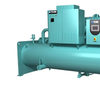Editor’s Note: Julius teamed up with Daikin Applied’s Phil Johnson, P.E., to author this piece.
The engineering community and the world embraced the ban of chlorofluorocarbon (CFC) as a means of protecting the ozone layer. The 1987 Montreal Protocol was a landmark decision for protection of the environment. The predominant use of CFC was in air-conditioning and refrigerating systems.
The refrigerant industry quickly switched to replacement refrigerants that had a zero-ozone depletion potential. Some of the common replacement refrigerants were R410A for air conditioners, including heat pumps, and R134a for chillers. While these refrigerants were good replacements for CFC, it also was known that these newer refrigerants would have to be changed in the future. While the replacement refrigerants have a zero-ozone depletion potential, they also have a high global warming potential.













